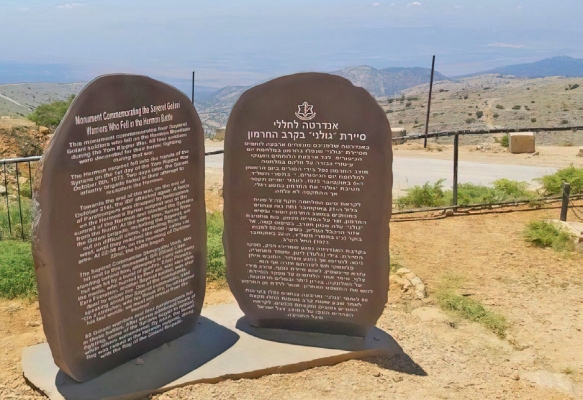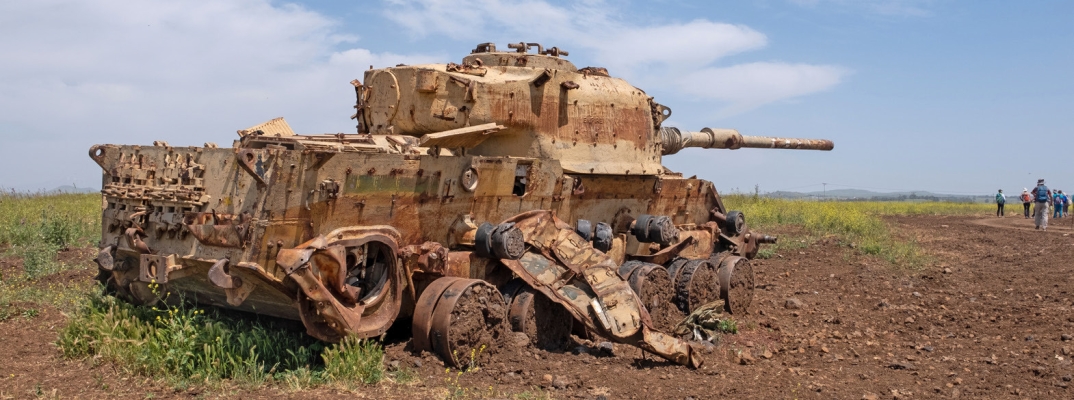Eitan Plonsky
Gan Eitan sign at Kibbutz Megiddo playground
Son of Holocaust Survivors, Killed Fighting in the Yom Kippur War
Text and photos by Lydia Aisenberg
The sun begins to call it a day, as long shadows begin to fall across the swings and slides in the toddlers' play area of Gan Eitan in Kibbutz Megiddo. Parents gather up scattered sandals and items of their offspring's discarded clothing before heading off, kinder in tow, to their nearby homes. A veil of silence descends on the playground which, moments before, had been filled with children's laughter, shouts and arguments over whose turn it was to be on the swings.
In a prominent corner of this popular playground, affixed to a large pinewood billboard, stands a large black and white head and shoulders photograph of Eitan Plonsky, seemingly gazing skyward with the hint of a smile playing on his lips. A snow-capped Mt. Hermon appears in the background behind the freckled faced, handsome young man with an Elvis style quaff covering part of his forehead. The playground is named after him.
Alongside the photograph, on a blue background, a lengthy text tells the story of the kibbutz born IDF commando Staff Sergeant Eitan Plonsky (21). A Syrian sniper's bullet killed him during the 1973 Yom Kippur War's infamous battle for the 2,800 meter above sea level summit of Mt. Hermon and control over the hilly range straddling the border between Syria and Lebanon.
Eitan, big brother to two kibbutz born sisters, served as a medic in Sayeret Golani. He died while attempting a heroic rescue of gravely injured comrades pinned down by heavy Syrian fire during fierce fighting when Israeli soldiers fought to take the crucially important Hermon mountain range and the strategically all-important Mt. Hermon summit itself.
The Sayeret Golani medic and three of his brothers-in-arms were killed close to each other; two days before a ceasefire was agreed upon with the Syrians came into effect.
Several monuments, hewn from volcanic rock, stand close to the spot where they fell, one of which describes in detail what happened that fateful day. It reads:
"This monument commemorates four Sayeret Golani soldiers who fell on the Hermon Mountain during the Yom Kippur War". All four soldiers were decorated for their heroic fighting during that war.
The Hermon outpost fell into the hands of the Syrians on the 1st day of the Yom Kippur War, October 6th, 1973. Two days later, the Golani infantry brigade failed in their attempt to recapture the Hermon.
Towards the end of the war, on the eve of October 21st, the IDF attacked again. A force of paratroopers was dropped by helicopters on the Hermon's Syrian outpost and at the summit of the Hermon and locked the Syrians from the north. At the same time forces from the Golani Brigade, including the Sayeret, set out on a difficult climb, ascending from the west until they reached the upper cable car area. At 02.00 a.m. on the morning of October 22nd, the battle began.
The Sayeret Commander, Sharyahu Vinik, was hit next to this monument. Gili (Gilad) Litan, standing behind him, attempted to carry him away but was hit by a burst of gunfire. Eitan Plonsky, the medic, who hurried to their aid, was also shot. Ezra Finnstein, another Sayeret soldier, was shot dead by sniper fire.
One of the combatants, speaking about the Sayeret commander, said: "On a stretcher, his throat dry, he whispered his last words: we must not retreat from the Hermon."
80 Golani warriors and four paratroopers fell in these battles. After seven additional hours of fighting some of the Syrians began to retreat, while others surrendered. By noon, the Israeli flag was raised at the Hermon outpost, along with the flag of the Golani Brigade."
Ascending to the site of the memorial by way of the Hermon ski-lift, this writer finds herself surrounded by a huge area of ominous looking grey and black rocks as well as summer, dried-to-a-crisp brown and yellow. vegetation. The views are breathtaking; as they incorporate both present-day nearby Syrian villages as well as – much further away and below – red roofed Israeli communities, developed since the 1967 capture of the Golan Heights, and the defeat of the Syrian forces.
The importance of conquering the Hermon mountain range that threatened a large portion of northern Israel – and the cost in lives of I.D.F. elite troops to achieve that conquest – is truly hammered home standing at this vantage point. Alongside the rock engraved memorials, and looking down, almost hovering over, one can see a huge expanse of rough terrain which, far into the lower hills and valleys stretched below, was the pre-1967 borders between Syria and Israel.
Both parents of Staff Sergeant Eitan Plonsky, David (Yurek) and Alexandra (Ohla) Plonsky , were Holocaust survivors and founding members of Kibbutz Megiddo. Kibbutz Megiddo, was founded in 1949. It is a community that sits tucked in above a narrow pass amongst the rolling Menashe hills behind the ancient mound of Tel Megiddo.
The kibbutz was founded on a ridge adjacent to the all-important historically strategical site of Megiddo, where major battles took place both in ancient and modern times. The impressive mound guarded and controlled the narrow pass leading through the western portion of the crucially important trade route linking Egypt, Mesopotamia and Asia Minor. This trade route was known as the Via Maris (the Way of the Sea), in Arabic as Wadi Ara, and, to most Israelis, by its highway road number: Route 65.
For many years Yurek, who died in 2009, shared his horrific and life scarring experiences that he suffered as a young teen in the Warsaw Ghetto during the Holocaust with Israeli high-school pupils, soldiers and students from abroad studying in Israel. He also accompanied Israelis on visits to Poland, including to the Warsaw Ghetto, and to other sites of Nazis atrocities.
In a speech delivered on Holocaust Day in 2009, the Israeli Prime Minister Binyamin Netanyahu paid tribute to Yurek saying:
"Before the recent Pesach holiday, a Jewish hero passed away. David Plonsky, also known as Yurek – may his memory be blessed – the cigarette salesman from the Triple Cross Square in Warsaw.
Yurek was only 14 when the Warsaw Ghetto was established. He turned from child into adult overnight. He smuggled food into the ghetto and his life was under constant threat. Yurek survived, immigrated to Israel, fought in the War of Independence, started a family, and built a home at Kibbutz Megiddo.
He lost his son Eitan during the Yom Kippur War, but found the fortitude to overcome this tragedy as well. He continued living, continued to build, and continued inculcating his legacy into thousands of youngsters.
His life story and activities are, to a large extent, a mirror of the Jewish people's transition from exile to liberty, a story of suffering, supreme heroism, construction, and renaissance; a story of bereavement, faith, and independence."
Yurek and this writer worked together for many years at the Givat Haviva Center for Peace Education and Shared Society. Traveling together on Route 65 most workday mornings, they discussed many issues, agreeing, and none-to-often, not. He often addressed this fellow traveler as "Maidele," even though she was already a grandmother herself.
At the Givat Haviva campus, Yurek often used a large glass encased model of the Warsaw Ghetto and maps showing the surrounding area. He would describe how slowly but surely the Jews of the city and outlying villages - like the one where his family used to live - were rounded up and forced into the ghetto. He would describe with outwardly chilling calmness but with inwardly, unseen, deeply felt, emotional turmoil the inhuman living conditions, overcrowding, starvation, sickness, and the constant dark shadow of death that hung over every man, woman and child.
Having fair hair, light skin and blue eyes allowed the barely teenaged Yurek to sneak in and out of the Ghetto by various means. Not only did he have to deal with avoiding the police and Nazis, but also, young Polish thugs waiting outside to prey on the child smugglers and cigarette sellers coming out of the ghetto.
"The thugs robbed us of what little we had and beat us to pulp," he once told this writer. On one occasion Yurek was caught by a German soldier who smashed his rifle butt in his face, breaking his nose, cheek bone and teeth – injuries that caused him pain for many years after. When his family was rounded up for transport, Yurek managed to escape through a small window and took to the ghetto sewers. For over 3 months he did not see the sky, a tree or daylight.
"In the Warsaw Ghetto uprising we fought with a few handguns, some of which were incapable of firing, and from my group of 34 fighters, only 7 survived. My son fought in a war, armed with modern weaponry, and died," he told this writer during one of those early morning journeys.
Staff Sergeant Eitan Plonsky, Yurek and Olah, who died in recent years, are all buried in the cemetery of Kibbutz Megiddo. They lie close to the adjacent famous archaeological and UNESCO World Heritage site, Tel Megiddo, which is believed by many to be the site of the final battle between the forces of good and evil at the end of time; known as Armageddon.










Comments